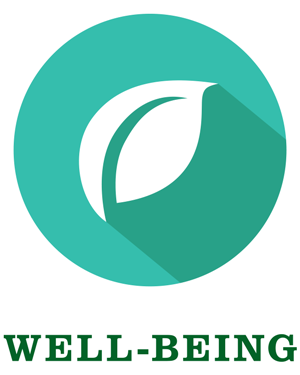- Strategic Plan
Overlake's definition of Well-Being

What does it mean to be well? As simple a question as that may be, there is no one simple answer that works for everyone. One’s wellness is measured individually according to each person’s individual needs. So, when Overlake took on the task of defining well-being and what that looks like on campus, it was a major undertaking.
“We are so proud to have made well-being a priority on this campus when the strategic plan was approved three years ago,” says Dr. Samantha Hillyer (’01), Director of Health and Wellness and lead of the Well-Being strategic plan pillar. “This is groundbreaking work to have a school-centered definition for well-being. It’s very authentic to us and really informed by our community values.”
Hillyer, along with a core group of cross-disciplinary faculty and staff has been busy working toward developing a school-centered definition for well-being. This team, comprised of Director of Student Support, Susan Essex, Upper School Assistant Head, Krishna Davda, Middle School Head, Mike Davidson, Human Relations Coordinator Kayleigh Harper, Strength & Conditioning Coach, Joey Swidler, MS SEL Program Coordinator, Kristina Rey, and Hillyer have diligently gathered feedback and ideas for all areas of the community, from employees, students, and parents/guardians.
“We started this process in the 2022-23 school year by asking all employees on a professional development day to help us craft a framework for this definition. We had many prompts around the different ways we contribute to well-being, similar to the PERMAH model created by psychologist Dr. Martin Seligman,” explains Hillyer. “We wanted to know what employees saw for themselves and for our students while on campus and how we interact with each of those aspects of well-being.”
After that session, the framework for a well-being definition began to take shape. Further insights from data provided by the High Achieving Student Survey (HASS) results provided the team with context to then hold student focus groups this past fall to gain additional feedback on a potential definition. “We continued to mold the definition and then also sent out a school-wide survey for feedback to all students and all employees,” explains Hillyer.
Further refined, the working definition of well-being was then shared last month during an evening parent seminar on campus. “We were so excited to share the results of our work over the past years. We had lovely engagement from our parents and guardians who were able to also provide ways in which they commit to providing well-being moments at home.” Those in attendance were asked to provide examples of ways to engage in well-being outside of school and here is a list of those ideas. “It is so important that we form a partnership with parents and guardians around well-being for our students,” says Hillyer.
Here is Overlake’s definition of well-being that will serve as our guideposts to our greater community:
At Overlake, we aspire to prioritize the well-being of all community members, including our students, employees, and parents/guardians. Well-being is a series of skills or abilities that form a critical foundation for success, belonging, and thriving. Our definition includes numerous types of well-being, and we hope individuals can fluidly prioritize and re-prioritize each component to ultimately find holistic well-being. We define well-being for our community members as follows:
- Social Well-being is the ability to build healthy relationships and genuine connections while maintaining boundaries through verbal and non-verbal communication.
- Physical Well-being is the ability to prioritize and maintain practices that contribute to a healthy body and mind, encompassing regular exercise, balanced nutrition, and sufficient restorative sleep. It includes fostering habits that optimize physical health to promote overall vitality and resilience.
- Academic/Intellectual Well-being is the ability to expand knowledge and support lifelong learning. It includes balancing academic and professional workloads, preparing and organizing for the future, utilizing resources to make decisions, demonstrating curiosity, welcoming new academic and professional challenges, and meeting academic and professional goals in a healthy way.
- Community Well-being is the ability to cultivate a sense of shared responsibility for our community and campus, fostering belonging by building cultural awareness, positive relationships, and respectful interactions. It also includes instilling a sense of pride in our community and nurturing an environment where everyone feels valued, empowered, and has a sense of belonging.
- Emotional Well-being is the ability to be aware of emotions in self and others, giving all the permission to feel and express emotion, building psychological habits and resources to build resilience, and executing strategies that help build mindfulness and find joy.
“A definition of well-being is challenging because it involves so many components, but it was important to us to find one that did fit Overlake specifically and what we both aspire to and uphold,” explains Hillyer. “It’s not that this definition couldn’t be applied to other institutions, but this is a definition that our community has helped develop and we feel good about what we believe well-being is here on campus.”
Hillyer says despite a well-being definition, the school’s work is never done. “The definition is a jumping-off point for us and will help drive our work in the same way that our mission, vision, and strategic plan do. It will help be the mirror when looking at new initiatives and whether the new ideas support and enhance our well-being definition.”
